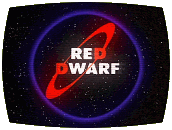 On Red Dwarf, a mining ship of the Jupiter Mining Corporation, the two lowest-ranking crewmembers, second technician Arnold J. Rimmer and third technician David Lister, are unable to agree on anything. Lister’s laid-back lifestyle and his refusal to deal with or, for that matter, acknowledge the existence of any problem unless his life depends on it irritates Rimmer, who sees himself as prime officer material despite his chronic inability to get a promotion. Lister is at least able to befriend a mechanoid named Kryten, and to Rimmer’s chagrin, the low-ranking Lister also has an ongoing relationship with one of the ship’s officers. Lister’s pet cat becomes something of a point of contention between Lister and Red Dwarf’s captain, who demands custody of the unauthorized and unquarantined animal. When Lister refuses, he is sentenced to make the rest of Red Dwarf’s journey in suspended animation without pay.
On Red Dwarf, a mining ship of the Jupiter Mining Corporation, the two lowest-ranking crewmembers, second technician Arnold J. Rimmer and third technician David Lister, are unable to agree on anything. Lister’s laid-back lifestyle and his refusal to deal with or, for that matter, acknowledge the existence of any problem unless his life depends on it irritates Rimmer, who sees himself as prime officer material despite his chronic inability to get a promotion. Lister is at least able to befriend a mechanoid named Kryten, and to Rimmer’s chagrin, the low-ranking Lister also has an ongoing relationship with one of the ship’s officers. Lister’s pet cat becomes something of a point of contention between Lister and Red Dwarf’s captain, who demands custody of the unauthorized and unquarantined animal. When Lister refuses, he is sentenced to make the rest of Red Dwarf’s journey in suspended animation without pay.
He is awakened from his time in stasis by the ship’s computer, Holly, who breaks the news to him that an in-flight accident killed all aboard except Lister, who was sealed safely in stasis, and his cat, who was safely sealed in a cargo bay. Holly then comforts Lister by revealing that this tragedy happened a long time ago – three million years, to be exact. As if that’s not enough, Rimmer has been revived as a hologram, unable to touch anything, but fully capable of getting on Lister’s nerves. And the generations of kittens born to Lister’s cat have evolved into a humanoid form of cat, with the outward appearance of a human being but the vanity and attitude of a tomcat on the make; one such creature, who winds up with the highly original name of Cat, is “adopted” by Lister. Kryten has also survived, but is now more eccentric than ever. Just when Lister is coming to terms with his new reality, that reality becomes more surreal when duplicates of the crew appear, claiming to be from the future…
written by Linwood Boomer
directed by Jeff Melman
music by Todd RundgrenCast: Craig Bierko (Lister), Chris Eigeman (Rimmer), Jane Leeves (Holly), Hinton Battle (Cat), Robert Llewellyn (Kryten), Lorraine Toussaint (Captain Tau), Elizabeth Morehead (Christine), Michael Heintzman (Munson)
Notes: Having gained legendary status for just how bad an attempt it was to “translate” Red Dwarf’s British humor for an American audience (which had already gotten addicted to the original show without the need for such translation), the first American Red Dwarf pilot remains unreleased to this day. Key scenes can be seen in a bonus feature on the Red Dwarf V DVD, Dwarfing
USA. After seeing this pilot, writer/creators Rob Grant and Doug Naylor stepped in with a script of their own for a second pilot, though it had to be mounted without the participation of Robert Llewellyn, who had returned to the UK by that time, and without Chris Eigeman and Hinton Battle, who had other work commitments. With the launch failure of American-flavored Red Dwarf, Jane Leeves was free to join the cast of Frasier as Daphne Moon, still probably her best-known role, while Craig Bierko went on to star in such films as Thirteenth Floor and The Long Kiss Goodnight, before winning and then turning down one of the starring male roles in a 1994 pilot for a sitcom called Friends. Tony-winning actor Hinton Battle later racked up a much more visible genre credit as a demon who made Buffy and friends literally sing out their innermost feelings in the Buffy The Vampire Slayer musical episode Once More With Feeling (2001); he had also appeared as the Evil Leaper’s equivalent of Dean Stockwell’s hologram character in Quantum Leap.
LogBook entry and review by Earl Green
Review: What’s different? Quite a lot, but perhaps not as much as one might expect. The major changes occur in the cast. Lister, in the U.S. version, is white, more or less 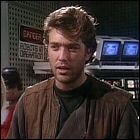 clean-cut aside from a bit of five o’ clock shadow, not at all the slobbish Lister of old. The closest Bierko’s Lister comes to the original character is a trace of laziness, a Kochanski fixation, and bucking Rimmer’s authority. He also doesn’t appear to be anything like out of shape or unkempt. Rimmer, on the other hand, is barely even a player in the cast – and his banter with Lister, which was the heart and soul of the BBC’s series (and arguably still should be), is barely present at all, certainly not with the lethal volleys of acid wit with which Craig Charles and Chris Barrie won a massive audience. Cat shows promise, but isn’t explored enough to see just which way that promise goes; Hinton Battle didn’t seem to preen as much as Danny John-Jules. Jane Leeves, known now for her role on NBC’s “Frasier” as well as her introduction to many Stateside viewers as one corner of the Taster’s Choice coffee love triangle advertising campaign, is a passable Holly, and she shows a *lot* of promise after 3,000,000 years pass (no offense, Jane!)! Christine Kochanski (Linwood Boomer must’ve missed the giant initials “K.K.” from the “Better Than Life” novel) is drastically changed – unfortunately into an all-too-typical blue-eyed blonde whose entire opinion of the noncommital Lister is turned around completely by his refusal to turn Frankenstein the cat over to the ship’s captain (who has also undergone a change or two). Winning her heart is still Lister’s motivation, but give me C.P. Grogan any day…
clean-cut aside from a bit of five o’ clock shadow, not at all the slobbish Lister of old. The closest Bierko’s Lister comes to the original character is a trace of laziness, a Kochanski fixation, and bucking Rimmer’s authority. He also doesn’t appear to be anything like out of shape or unkempt. Rimmer, on the other hand, is barely even a player in the cast – and his banter with Lister, which was the heart and soul of the BBC’s series (and arguably still should be), is barely present at all, certainly not with the lethal volleys of acid wit with which Craig Charles and Chris Barrie won a massive audience. Cat shows promise, but isn’t explored enough to see just which way that promise goes; Hinton Battle didn’t seem to preen as much as Danny John-Jules. Jane Leeves, known now for her role on NBC’s “Frasier” as well as her introduction to many Stateside viewers as one corner of the Taster’s Choice coffee love triangle advertising campaign, is a passable Holly, and she shows a *lot* of promise after 3,000,000 years pass (no offense, Jane!)! Christine Kochanski (Linwood Boomer must’ve missed the giant initials “K.K.” from the “Better Than Life” novel) is drastically changed – unfortunately into an all-too-typical blue-eyed blonde whose entire opinion of the noncommital Lister is turned around completely by his refusal to turn Frankenstein the cat over to the ship’s captain (who has also undergone a change or two). Winning her heart is still Lister’s motivation, but give me C.P. Grogan any day…
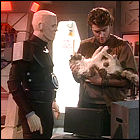 Kryten is played by the original cast’s Robert Llewellyn in much the same manner, but of course fans of the BBC’s Red Dwarf will be a little surprised to see his function in what amounts to a rewrite of The End, which had no Kryten in its original incarnation. He does have the same “jerky middle name,” however, and gets one really hilarious line in
Kryten is played by the original cast’s Robert Llewellyn in much the same manner, but of course fans of the BBC’s Red Dwarf will be a little surprised to see his function in what amounts to a rewrite of The End, which had no Kryten in its original incarnation. He does have the same “jerky middle name,” however, and gets one really hilarious line in 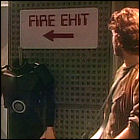 (Lister: “You’ve been sitting here [dismantled in the ship’s lab] for three million years? What’ve you been doing all that time?” Kryten: “Reading that ‘fire exit’ sign [over the door – it simply reads ‘fire exit’]…it’s given me a lot of solace over the years.”) Craig Bierko went on to become a regular on the short-lived NBC sitcom Pride & Joy.
(Lister: “You’ve been sitting here [dismantled in the ship’s lab] for three million years? What’ve you been doing all that time?” Kryten: “Reading that ‘fire exit’ sign [over the door – it simply reads ‘fire exit’]…it’s given me a lot of solace over the years.”) Craig Bierko went on to become a regular on the short-lived NBC sitcom Pride & Joy.
What remains the same: since the only existing version of this is a presentation for prospective commercial backers, the BBC’s special effects shots were slotted in for transition shots. It is unknown 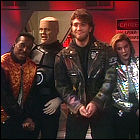 whether these would have been used had the series made it past the pilot stage, though it is interesting to note that the computer screens on the bridge display a rotating 3-D “wire frame” graphic of the Red Dwarf as seen in the original series. And that brings us to the bridge – as well as the bunkroom. These sets are almost identical to the BBC’s third series sets, it’s uncanny! It also gives one a fair idea of budgeting for the U.S. pilot – the sets may have been considered cheap by the American producers, while building their British counterparts was quite an item in the BBC’s budget for the show. As a curious footnote – the sets have made it to the airwaves, as the flight deck of the doomed spaceliner in the doomed Fox Movie of the Week “Lifepod.” Also, about one-third of the script, surprisingly, remained untouched. Both Lister and Rimmer used the word “smeg” in the course of the episode, and even more amazingly, in the opening moments a lazy skutter gives Rimmer the bird!
whether these would have been used had the series made it past the pilot stage, though it is interesting to note that the computer screens on the bridge display a rotating 3-D “wire frame” graphic of the Red Dwarf as seen in the original series. And that brings us to the bridge – as well as the bunkroom. These sets are almost identical to the BBC’s third series sets, it’s uncanny! It also gives one a fair idea of budgeting for the U.S. pilot – the sets may have been considered cheap by the American producers, while building their British counterparts was quite an item in the BBC’s budget for the show. As a curious footnote – the sets have made it to the airwaves, as the flight deck of the doomed spaceliner in the doomed Fox Movie of the Week “Lifepod.” Also, about one-third of the script, surprisingly, remained untouched. Both Lister and Rimmer used the word “smeg” in the course of the episode, and even more amazingly, in the opening moments a lazy skutter gives Rimmer the bird!
In one really surprising instance, the American script gets a bigger laugh than its British forebear. The End features a line 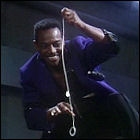 where Rimmer, when trying to describe the feeling of death to Lister, says it’s “like being on holiday with a group of Germans.” In the U.S. version, this line is changed to “It’s like being at an Amish bachelor party.” But we can’t let it get away with a completely glowing review. There are some problems as well, including a horrible $50-Casio-portable-keyboard-demo theme song and an only marginally more listenable score by Todd Rundgren (I hope this just means he was paid a pittance to do this, we know he can do better than that!). Cat and Rimmer are given little time to develop their characters, which is not a good omen since the original Red Dwarf’s main point of character study was the constant banter between Lister and Rimmer. Also, some bits of the script – you know it had to happen – ended up getting “Americanized” so the audience could keep up with it (time and time again, how often do we have to tell U.S. TV producers that we can keep up with the British version just fine, otherwise how’d the show get such a following?!), including one line from Lister that after 3,000,000 years, his baseball cards will be worth a fortune. Also jettisoned from the script was the idea of Lister being God to the Cat’s ancestors – it was barely even paid mention in this incarnation.
where Rimmer, when trying to describe the feeling of death to Lister, says it’s “like being on holiday with a group of Germans.” In the U.S. version, this line is changed to “It’s like being at an Amish bachelor party.” But we can’t let it get away with a completely glowing review. There are some problems as well, including a horrible $50-Casio-portable-keyboard-demo theme song and an only marginally more listenable score by Todd Rundgren (I hope this just means he was paid a pittance to do this, we know he can do better than that!). Cat and Rimmer are given little time to develop their characters, which is not a good omen since the original Red Dwarf’s main point of character study was the constant banter between Lister and Rimmer. Also, some bits of the script – you know it had to happen – ended up getting “Americanized” so the audience could keep up with it (time and time again, how often do we have to tell U.S. TV producers that we can keep up with the British version just fine, otherwise how’d the show get such a following?!), including one line from Lister that after 3,000,000 years, his baseball cards will be worth a fortune. Also jettisoned from the script was the idea of Lister being God to the Cat’s ancestors – it was barely even paid mention in this incarnation.
Interestingly enough, a “Captain Tau” character appears in the “real” Red Dwarf’s sixth series episode Psirens – albeit in a far more brief appearance than the completely unrelated character in this story – just in case anyone wants to keep track of these weird little coincidences. Oh, and the American producers ripped off the far-too-speedy-Star Wars– style-scrolling-introduction gag from Backwards, too. It went something like this:
RED DWARF – The story so far…by the latter half of the twenty-second century, huge space cruisers powered by hydrogen ram-jet drives had colonized the outer fringes of our solar system.
Human kind was poised to explore the dark mysteries of deep space. We wish we could have told you stories about these brave men and women, but we couldn’t afford it. Instead, what you’re getting is this. This is the story of a beat-up old mining ship which ambles between Earth and the moons of Saturn, transporting raw materials. Is it just me, or does this sound really tedious? No one’s going to like this. A show about people who move rocks from planet to planet? Intergalactic rock movers? Who are we kidding? I didn’t even want to be a writer. Do you realize how hard it is to type this fast? My fingers are bleeding. Uh oh. Looks like we’re slowing back down. I’d better start making sense again, so all the cheapos who don’t have a VCR with freeze-frame will think they really missed out on something important. Ahem……which you really need to know to understand this story.
